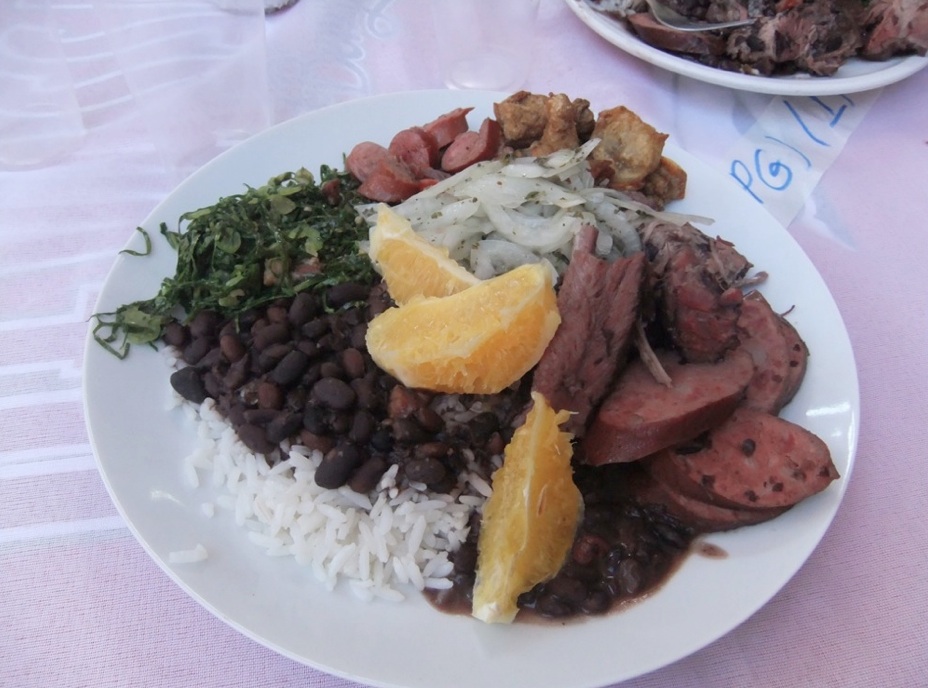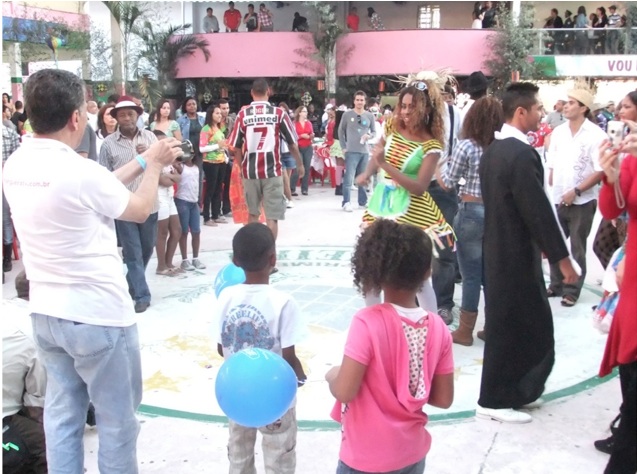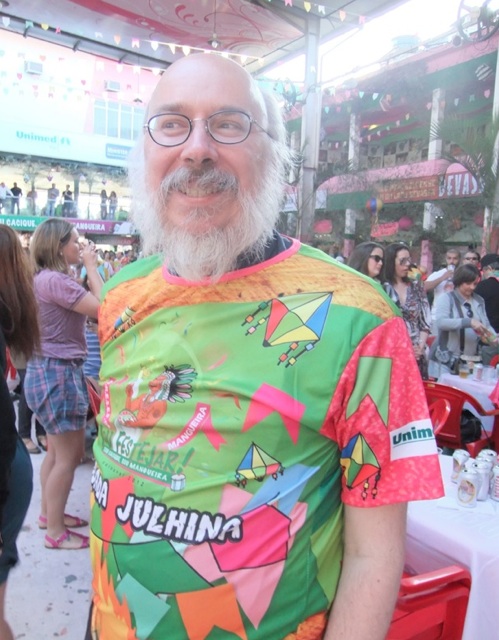What Samba Schools Can Teach Us About Participatory Culture
/If you dropped in at a Samba School on a typical Saturday night you would take it for a dance hall. The dominant activity is dancing, with the expected accompaniment of drinking, talking and observing the scene. From time to time the dancing stops and someone sings a lyric or makes a short speech over a very loud P.A. system. You would soon begin to realize that there is more continuity, social cohesion and long term common purpose than amongst transient or even regular dancers in a typical American dance hall. The point is that the Samba School has another purpose then the fun of the particular evening. This purpose is related to the famous Carnival which will dominate Rio at Mardi Gras and at which each Samba School will take on a segment of the more than twenty-four hour long procession of street dancing. This segment will be an elaborately prepared, decorated and choreographed presentation of a story, typically a folk tale rewritten with lyrics, music and dance newly composed during the previous year. So we see the complex functions of the Samba School. While people have come to dance, they are simultaneously participating in the choice, and elaboration of the theme of the next carnival; the lyrics sung between the dances are proposals for inclusion; the dancing is also the audition, at once competitive and supportive, for the leading roles, the rehearsal and the training school for dancers at all levels of ability. From this point of view a very remarkable aspect of the Samba School is the presence in one place of people engaged in a common activity - dancing - at all levels of competence from beginning children who seem scarcely yet able to talk, to superstars who would not be put to shame by the soloists of dance companies anywhere in the world. The fact of being together would in itself be "educational" for the beginners; but what is more deeply so is the degree of interaction between dancers of different levels of competence. From time to time a dancer will gather a group of others to work together on some technical aspect; the life of the group might be ten minutes or half an hour, its average age five or twenty five, its mode of operation might be highly didactic or more simply a chance to interact with a more advanced dancer. The details are not important: what counts is the weaving of education into the larger, richer cultural-social experience of the Samba School.
So we have as our problem: to transfer the positive features of the Samba School into the context of learning traditional "school material" -- let's say mathematics or grammar. Can we solve it? -- Seymour Papert, "Some Poetic and Social Critera for Education Design" (1975)
I was lucky enough to have spent some small bits of time with Seymour Papert when I first arrived at MIT in the late 1980s and to have spent even more time in the company of his students, such as Amy Bruckman, Idit Harel Caperton, Edith Ackerman, Ricki Goldman, Mitchell Resnick, David Cavallo, and others. His ideas about redesigning educational practices to reflect the value of the Samba Schools was very much in the air at the time and I recall this passage being discussed several times at the meetings of the Narrative Intelligence Reading Group, an incredible bunch of graduate students, faculty members, and folks from the Cambridge community, who met regularly to discuss the intersection between new media and theory. In retrospect, I've begun to wonder how much the concept of the Samba School informed my own ideas about "participatory culture," without me being fully conscious of it at the time. It is only in recent years that I have started to draw connections between the two, but we are always shaped by things in our immediate environment in ways we can not fully articulate at the time. So, choose your contexts wisely.
This past summer, during a trip to Rio, my wife and I were finally able to visit a Samba School, and I came away from the experience with a deeper appreciation of the many different mechanisms through which the community's participation is solicited and maintained over the course of one of those weekend afternoons Papert is describing. And I have found myself reflecting upon this experience many times since my return. Here, I mostly want to share some of the beautiful photographs my wife, Cynthia Jenkins, took, but also to share a few of these still relatively unprocessed impressions. Thanks to my good friend, Mauricio Mota, for organizing our outing at the Samba School. I am still learning about this culture, so please excuse anything I get wrong in this discussion. I would love to have some of my Brazillian readers add their own background and context to what I am sharing here.
The Samba Schools are embedded within particular communities -- most often in the Favelas, which is where the poorest of the poor live in Rio. Upon entering these communities, as an outsider, one is impressed both by the density of the population and by the vibrancy of community life. Everywhere you look, people are gathered together, engaged in conversations, and around the edges, you can see a range of expressive activities.
For me, the creativity fostered by the Samba Schools is also visible in the grafitti and street art which adorns walls all over the city. And the playfulness can be seen in the boys and girls who are trying to conduct kite battles just outside the city center.
The Samba Schools are part of a larger folk logic which survives in Brazil as a living aspect of the culture (even as so much of the folk practices have been crushed in the United States over the past hundred plus years of mass media). We don't need to romanticize these creative impulses, but we also should not deny their existence.
Entering the Samba School has historically been a risky proposition for the middle class and the outsider, as is suggested by the incredibly narrow windows through which transactions occur around the purchase of admission.
But once inside the hall, things are incredibly open and designed to insure sociability through every means possible. The space and practices are designed to encourage participation and to embrace many different kinds of participation. So, the first thing you do upon entering -- or at least the first thing we do upon entering -- is to grab a big heaping plate of food.
As someone born and raised in the south, not so many generations removed from dirt farmers, I recognize the core ingredients here -- there's not much on my plate which I would not have seen at a BBQ place in the deep south or at a family reunion or church picnic. The preparation differs, of course, but the core building blocks are the same. And eating the food gives us time to sit and watch, to get our bearings and to develop a mental map of the space.
The design of the space creates a great deal of fluidity between watching and dancing.
There are many different vantage points for observing what's taking place, but there are no fixed walls separating performance space for spaces where spectators are gathered.
And the longer you are there, the more you find yourself edging closer and closer to where the action is. There is no decisive moment when participants step from watching to dancing. The music pulls at you -- you start to sway your hips or nod along without even fully realizing it.
Mothers and fathers are taking their children with them, and they bounce to the music, even before they really know what's taking place.
There are certainly stars to be seen here: my host points out some of the well known figures in the Samba world who are strutting their stuff and others are gathering around to watch them, but there is nothing stopping anyone from stepping into the same ring on the flat floor and dancing alongside them.
There is a raised area where the bands perform and there are local personalities who moderate the festivities, giving out periodic encouragements for people to join the dance. The announcers, though, are only one of a number of different practices designed to actively invite our participation.
These young men and women function like cupids: they bring love messages from one participant to another, often encouraging them to kiss and dance together, and thus breaking down some of the isolation that might remain in a large public space. You may note that they wear straw hats and have freckles, both intended to indicate they are playing the role of "country bumpkins," a shared figure of bemusement for these urban poor, many of whom only recently left the countryside themselves.
Periodically, a group dressed in police uniforms step march through the hall, blowing whistles, and rounding up captives. They are seeking out people who do not seem to be participating and they take them away for short lectures on the traditions of the community.
As someone who lives in fear of confrontations with people in uniforms, I ask my host what I can do to signal my participation, and it turns out that participation is a flexible category and that wearing the festive shirt which was handed me along with my ticket will be enough to signal that I have become part of the community, rather than a mere spectator.
The "participation police," as I have come to describe them, are one of the most provocative aspects of the experience for me. They speak to the challenges which any participatory culture faces around nonparticipation. I have come to appreciate the concept of legitimate peripheral participation -- the idea that witnessing and learning are themselves forms of participation, or at least, meaningful part of the process of preparing to participate. We should be concerned if some groups are structurally prohibited from participating; we should pay attention to the educational needs of those who are not yet ready to participate; we should build in active mechanisms which repeatedly encourage and solicit participation, as I observed in the Samba Schools, but we should not force participation before any given community member is ready to join the festivities.
So, it is striking that the Samba Schools have a range of different mechanisms for encouraging participation, some more forceful than others, but that it also recognizes and values that sometimes wearing a t-shirt or some other marker of affiliation may be as far as any one person is ready to go in their process of absorbing the norms and values of the community and crossing the invisible threshold into full participation. As we follow Papert's lead, and think about what it would mean to design educational institutions and practices which mirror those of participatory culture, we need to be attentive to the varied and multiple ways that spaces like the Samba School enable meaningful participation for all of their community members.












